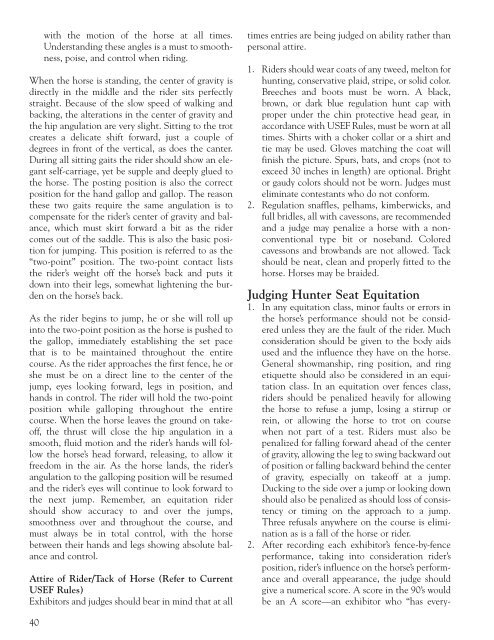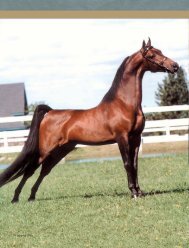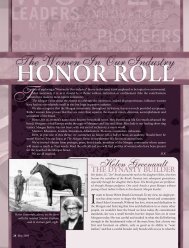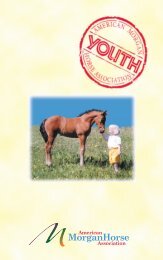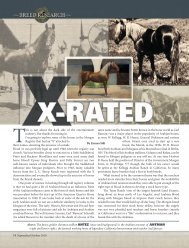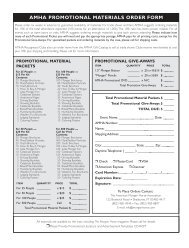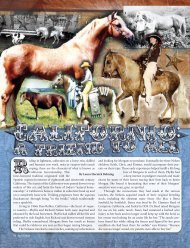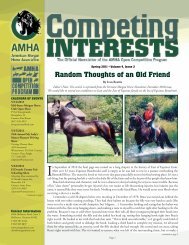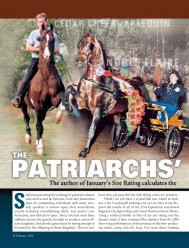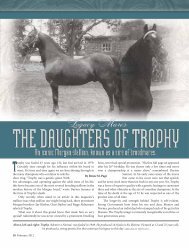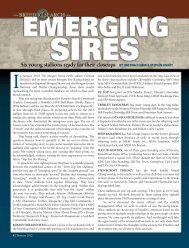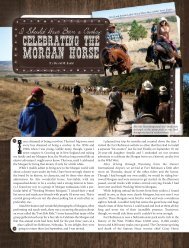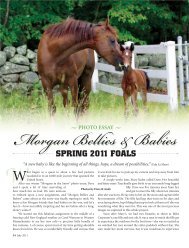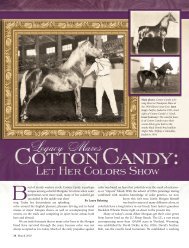Judging School Handbook - American Morgan Horse Association
Judging School Handbook - American Morgan Horse Association
Judging School Handbook - American Morgan Horse Association
You also want an ePaper? Increase the reach of your titles
YUMPU automatically turns print PDFs into web optimized ePapers that Google loves.
with the motion of the horse at all times.Understanding these angles is a must to smoothness,poise, and control when riding.When the horse is standing, the center of gravity isdirectly in the middle and the rider sits perfectlystraight. Because of the slow speed of walking andbacking, the alterations in the center of gravity andthe hip angulation are very slight. Sitting to the trotcreates a delicate shift forward, just a couple ofdegrees in front of the vertical, as does the canter.During all sitting gaits the rider should show an elegantself-carriage, yet be supple and deeply glued tothe horse. The posting position is also the correctposition for the hand gallop and gallop. The reasonthese two gaits require the same angulation is tocompensate for the rider’s center of gravity and balance,which must skirt forward a bit as the ridercomes out of the saddle. This is also the basic positionfor jumping. This position is referred to as the“two-point” position. The two-point contact liststhe rider’s weight off the horse’s back and puts itdown into their legs, somewhat lightening the burdenon the horse’s back.As the rider begins to jump, he or she will roll upinto the two-point position as the horse is pushed tothe gallop, immediately establishing the set pacethat is to be maintained throughout the entirecourse. As the rider approaches the first fence, he orshe must be on a direct line to the center of thejump, eyes looking forward, legs in position, andhands in control. The rider will hold the two-pointposition while galloping throughout the entirecourse. When the horse leaves the ground on takeoff,the thrust will close the hip angulation in asmooth, fluid motion and the rider’s hands will followthe horse’s head forward, releasing, to allow itfreedom in the air. As the horse lands, the rider’sangulation to the galloping position will be resumedand the rider’s eyes will continue to look forward tothe next jump. Remember, an equitation ridershould show accuracy to and over the jumps,smoothness over and throughout the course, andmust always be in total control, with the horsebetween their hands and legs showing absolute balanceand control.Attire of Rider/Tack of <strong>Horse</strong> (Refer to CurrentUSEF Rules)Exhibitors and judges should bear in mind that at alltimes entries are being judged on ability rather thanpersonal attire.1. Riders should wear coats of any tweed, melton forhunting, conservative plaid, stripe, or solid color.Breeches and boots must be worn. A black,brown, or dark blue regulation hunt cap withproper under the chin protective head gear, inaccordance with USEF Rules, must be worn at alltimes. Shirts with a choker collar or a shirt andtie may be used. Gloves matching the coat willfinish the picture. Spurs, bats, and crops (not toexceed 30 inches in length) are optional. Brightor gaudy colors should not be worn. Judges musteliminate contestants who do not conform.2. Regulation snaffles, pelhams, kimberwicks, andfull bridles, all with cavessons, are recommendedand a judge may penalize a horse with a nonconventionaltype bit or noseband. Coloredcavessons and browbands are not allowed. Tackshould be neat, clean and properly fitted to thehorse. <strong>Horse</strong>s may be braided.<strong>Judging</strong> Hunter Seat Equitation1. In any equitation class, minor faults or errors inthe horse’s performance should not be consideredunless they are the fault of the rider. Muchconsideration should be given to the body aidsused and the influence they have on the horse.General showmanship, ring position, and ringetiquette should also be considered in an equitationclass. In an equitation over fences class,riders should be penalized heavily for allowingthe horse to refuse a jump, losing a stirrup orrein, or allowing the horse to trot on coursewhen not part of a test. Riders must also bepenalized for falling forward ahead of the centerof gravity, allowing the leg to swing backward outof position or falling backward behind the centerof gravity, especially on takeoff at a jump.Ducking to the side over a jump or looking downshould also be penalized as should loss of consistencyor timing on the approach to a jump.Three refusals anywhere on the course is eliminationas is a fall of the horse or rider.2. After recording each exhibitor’s fence-by-fenceperformance, taking into consideration rider’sposition, rider’s influence on the horse’s performanceand overall appearance, the judge shouldgive a numerical score. A score in the 90’s wouldbe an A score—an exhibitor who “has every-40


